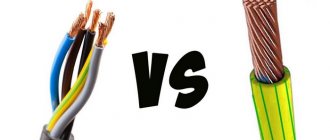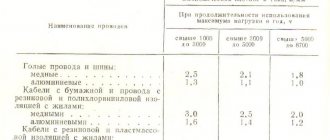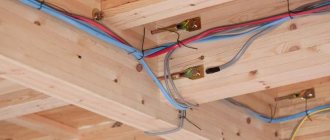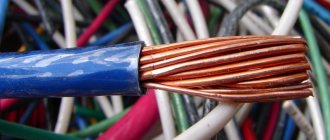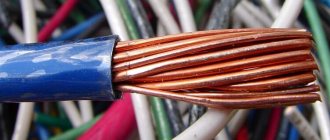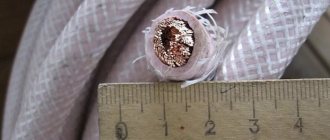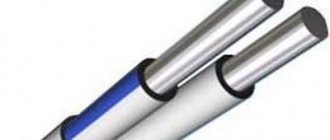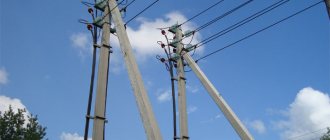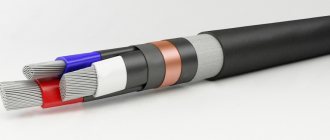Selecting a cable for electrical wiring installation, turnkey electrical installation in Ryazan
Cable is one of the main components of structured cabling systems (SCS). The main function of a cable is to transmit an electrical signal from one active device to another. There are many types of cables that are used for different purposes and operate under different conditions. The quality of the signal transmitted through it depends on the correct installation of cables. Each cable has certain installation conditions, and only if these conditions are met will the cable system meet the characteristics declared by the manufacturer. Violation of installation rules can ultimately lead to the inoperability of the entire system.
Types of cables, wires and cords used in electrical installations
In our work, we always follow all standards, rules and recommendations for laying the cable system. Our company’s engineers constantly monitor work at the site and monitor compliance with all technical conditions.
Main types of cables and wires
, used during installation in an apartment or private house, need to be considered in more detail. Careful information about them is required when purchasing, installing, operating and repairing them.
Power cables
Among the most popular types of cable products recently are the VVG cable and its modifications.
VVG
- denotes
a power cable
with TPZh PVC insulation, a PVC sheath (cambric), and copper core material, which does not have external protection. Used for transmission and distribution of electric current, operating voltage - 660–1000 V, frequency - 50 Hz. The number of cores can vary from 1 to 5. Cross-section - from 1.5 to 240 mm².
In domestic conditions, a cable with a cross-section of 1.5–6 mm² is used; in the construction of a private house, a cable with a cross-section of up to 16 mm² is used. The cores can be either single- or multi-wire. There are no restrictions - you can install a cable with a cross-section of 10 mm² in an apartment.
VVG is used over a wide temperature range: from –50 to + 50 °C. Withstands humidity up to 98% at temperatures up to +40 °C. The cable is strong enough to withstand tearing and bending, and is resistant to aggressive chemicals. When installing, remember that each cable or wire has a certain bending radius. This means that for a rotation of 90 °C in the case of VVG, the bending radius must be at least 10 diameters of the cable section.
In case of flat cable or wire
The width of the plane is considered. The outer shell is usually black, although sometimes white can be found. Does not spread fire. TPG insulation is marked in various colors: blue, yellow-green, brown, white with a blue stripe, red and black. The cable is packaged in coils of 100 and 200 m. Sometimes other sizes are also found.
VVG cable cross-section
Types of VVG cable:
- AVVG
- the same characteristics, only instead of a copper core, an aluminum core is used;
AVVG cable
- VVGng
- cambric with increased combustion protection;
Cable VVGng LS
- VVGp
is the most common type; the cable cross-section is not round, but flat; - VVGz
- the space between the TPG insulation and the cambric is filled with PVC strands or a rubber mixture.
NYM
does not have a Russian decoding of the letter designation.
This is a copper power cable with
TPZh PVC insulation, the outer sheath is made of non-flammable PVC. Between the layers of insulation there is a filler in the form of coated rubber, which gives the cable increased strength and heat resistance. The cores are multi-wire, always copper.
NYM cable: 1 - copper core; 2 - PVC shell; 3 - longitudinal non-flammable sealing; 4 - PVC insulation
Number of cores - from 2 to 5, cross-section - from 1.5 to 16 mm². Designed for carrying out lighting and power networks with a voltage of 660 V. It has high moisture and heat resistance. Can be used for outdoor installation. Operating temperature range – from –40 to +70 °C.
Disadvantage: does not withstand sunlight well, so the cable must be covered. Compared to VVG of any type, it is more durable and convenient to use. However, it only comes with a round cross-section (it is inconvenient to install in plaster or concrete) and is significantly more expensive than VVG. Bending radius - 4 cable cross-section diameters.
KG cable
KG
deciphered very simply -
the cable is flexible
. This is a conductor with an operating alternating voltage of up to 660 V, a frequency of up to 400 Hz or a direct voltage of 1000 V. The conductors are copper, flexible or highly flexible. Their number varies from 1 to 6. TPG insulation is rubber, the outer shell is made of the same material. Operating temperature range – from –60 to +50 °C. The cable is mainly used to connect various portable devices. Most often these are welding machines, generators, heat guns, etc. There is a type of KGng with non-combustible insulation.
Note
KG has proven itself excellently as a cable that operates under almost any outdoor conditions. At a construction site, it is simply irreplaceable for pulling power lines. Although some original people, attracted by the flexibility and reliability of the KG, install it as home wiring.
VBBShv - armored power cable with copper conductors
. The latter can be either single-wire or multi-wire. Number of cores - from 1 to 5. Cross-section - from 1.5 mm² to 240 mm². TPG insulation, outer shell, space between insulation and cambric - PVC is used in all these places. Then comes the armor of two tapes, wound in such a way that the outer one overlaps the boundaries of the turns of the lower one. On top of the armor, the cable is enclosed in a protective PVC hose, and the VBBShvng modification uses this material of reduced flammability.
Cable VBBShv
VBBShv is designed for alternating rated voltages of 660 and 1000 V. Single-core modifications are used to conduct direct current. Installed in pipes, ground and outdoors with protection from the sun. Operating temperature range – from –50 to +50 °C. Moisture resistant: at a temperature of +35 °C it can withstand 98% humidity. It is used when conducting electricity for stationary installations, as well as supplying electricity to detached objects. Bending radius is at least 10 cable cross-section diameters. VBBSHv is perfect for underground supply of electricity to a separate building.
Modifications:
AVBBSHv
— cable with aluminum core;
VBBShvng
- non-flammable cable;
VBBShvng-LS
— non-flammable cable with low gas and smoke emissions at elevated temperatures.
Selection of cable cross-section for voltages up to 1000 V
Selection of cable cross-section for voltages up to 1000 V, regardless of whether it is an electric motor or another load. It comes down to determining long-term permissible currents, that is, a cable cross-section is selected that allows it to withstand long-term design currents for a given section, without causing damage to the cable. The values of permissible continuous currents for cables and wires are indicated in the PUE tables 1.3.4 – 1.3.30, GOST 31996-2012, or use the manufacturer’s catalog data.
Continuously permissible current:
- for electrical receivers:
- for electric motor:
When choosing a cable cross-section, you need to take into account correction factors for ground and air when laying the cable, see PUE tables 1.3.3, 1.3.23, 1.3.26.
The determination of the actual long-term permissible current, taking into account correction factors in accordance with the PUE, is determined by the formula:
Where:
- Id.t. – long-term permissible current for the selected cable cross-section, selected according to GOST 31996-2012 or determined from the manufacturer’s catalogs.
- k1 – correction factor taking into account the temperature of the environment different from the calculated one, selected according to Table 1.3.3 of the Electrical Installation Regulations.
- k2 is a correction factor that takes into account soil resistivity (taking into account geological surveys), selected according to the PUE table 1.3.23.
- k3 – correction factor that takes into account the reduction in current load with the number of operating cables in one trench (in pipes or without pipes), selected according to the PUE table 1.3.26.
In this case, the following condition must be met:
If > Icalc.
Checking the cross-section according to the condition of compliance with the selected device for maximum current protection:
The cross-section of the cable (wire), according to the condition of compliance of the selected device with maximum current protection, is determined by the formula:
Where:
- Idef. – setting current at which the protective device is triggered;
- kdef. – coefficient of multiplicity of the long-term permissible current of the cable (wire) to the operating current of the protective device.
Iprotect value data and kdef. Can be determined from table 8.7 [L5. With. 207].
Checking the section for mechanical strength
The selected cable (wire) cross-section must be no less than that given in the PUE, Table 2.1.1.
Checking the cross section for voltage loss
After you have chosen the cable cross-section for the long-term permissible current, you need to check the cable for permissible voltage losses. That is, the voltage deviation of the pantographs connected to this network did not go beyond the permissible limits.
According to the standards, the following limits of voltage deviations at the terminals of pantographs are allowed [L1. p. 144].
Voltage loss ∆U for a three-phase line is determined by the formulas [L1. from 144]:
1. At the end of the line one load is connected:
2. Several (n) loads are connected along the length of the line:
Where:
- Icalc. – design current, A;
- L – section length, km;
- cosφ – power factor;
- r0 and x0 - the values of active and reactive resistances are determined according to table 2-5 [L2.s 48].
Voltage loss ∆U for a three-phase line can be determined using simplified formulas:
1. At the end of the line one load is connected:
2. Several (n) loads are connected along the length of the line:
Where:
- P – design power, W;
- L – length of the section, m;
- U – voltage, V;
- γ – specific electrical conductivity of the wire, m/Ohm*mm2;
- for copper γ = 57 m/Ohm*mm2;
- for aluminum γ = 31.7 m/Ohm*mm2;
Voltage loss ∆U for direct and single-phase alternating current can be determined using simplified formulas:
1. At the end of the line one load is connected:
2. Several (n) loads are connected along the length of the line:
where: s – cable cross-section, mm2;
Literature:
1. Electrician's reference book. Under the general editorship of V.I. Grigorieva. 2004 2. Design of cable networks and wiring. Khromchenko G.E. 1980 3. GOST 31996-2012 Power cables with plastic insulation for rated voltage 0.66, 1 and 3 kV. 4. Rules for the construction of electrical installations (PUE). Seventh edition. 2008 5. Calculation and design of power supply systems for facilities and installations. Publishing house TPU. Tomsk 2006
All the best! See you again on the Raschet.info website.
Wires
The most popular types of wire are PBPP (PUNP) and PBPPg (PUGNP). It is difficult to pronounce the letter combination PBPPg, so it is more often called PUNP or PUGNP. PBPP (PUNP)
refers to installation, or installation.
PBPP wire
The wire
is flat
, with single-wire copper cores covered with PVC insulation, the outer sheath is also made of PVC. Number of cores - 2 or 3, cross-section - from 1.5 to 6 mm². It is used when laying stationary lighting systems, as well as for installing sockets, although it is preferable to use it specifically for lighting. Rated voltage - up to 250 V, frequency - 50 Hz. Operating temperature range – from –15 to +50 °C. The bending radius is at least 10 diameters.
PBPPg (PUGNP)
differs from PUGNP in conductors - they are multi-wire. That is why the letter “g” is added to the name of the wire - flexible. All other characteristics correspond to PUNP, only the minimum bending radius is 6. A distinctive property is flexibility, therefore PUGNP are laid in places where the wiring makes frequent bends, or for connection to the network of household appliances. Wires of these brands are sold in coils of 100 and 200 m. The color is usually white, less often black.
Wire PUGNP
A type of PUNP includes a wire with aluminum conductors - APUNP
It has exactly the same characteristics as PUNP, adjusted for the core material. The only difference is that APUNP cannot be multi-wire, and therefore flexible.
Note
In general, wires of the PUNP, PUGNP and APUNP brands have proven themselves to be excellent household wires. In half the cases the master has to deal with them. However, it should be remembered that these brands of wires are highly specialized, and you should not use them instead of power cables (such as NYM or VVG).
Attention!
The popularity of PUNP and PUGNP wires is based primarily on price. However, there is a catch in this. The fact is that recently a discrepancy has been noticed between the declared cross-section of the wire cores and the actual one. After checking, it turned out that the wire marked PUGNP 3 x 1.5 is actually 3 x 1 - that is, the actual cross-section of the core is smaller. The same applies to isolation. When purchasing wires of this brand, it is necessary to measure the cross-section of the conductors and the thickness of the insulation.
PPV
-
copper wire with PVC insulation
. The wire is flat with dividing jumpers. The core is single-wire, with a cross-section from 0.75 to 6 mm². Number of cores - 2 or 3. Used for installation of stationary lighting systems and laying power lines. Rated voltage - up to 450 V, frequency - up to 400 Hz. The wire is resistant to aggressive chemical environments, non-flammable, and has a wide operating temperature range - from –50 to +70 °C. Moisture resistance - 100% at a temperature of +35 °C. The bending radius during installation is at least 10 diameters of the wire cross-section. Resistant to mechanical damage and vibration.
APPV
has the same characteristics as PPV, with the exception of the core material - it is aluminum.
Wires PPV and APPV
Automatic reclosing
— aluminum single-core wire with PVC insulation. The wire is round, single-wire with a cross-section from 2.5 to 16 mm² and multi-wire - from 25 to 95 mm².
Autoreclose wire
The wire
used in almost all types of installation of stationary lighting and power systems. It is laid in voids, pipes, steel and plastic trays. Widely used in the installation of distribution boards. Chemically resistant, operating temperature range from –50 to +70 °C. Moisture resistance - 100% at a temperature of +35 °C. The bending radius is at least 10 diameters. Resistant to mechanical damage and vibration.
PV wire 1
The appearance and characteristics of PV 1 are identical in everything to APV, except for the core material: copper instead of aluminum. The core cross-section starts from 0.75 mm². In addition, the core becomes stranded not from 25, but from 16 mm². More flexible than automatic reclosure.
The characteristics of wire PV 3 coincide with the properties of automatic reclosure and PV 1. Area of application - installation of sections of lighting and power circuits where frequent bending of wires is necessary: in distribution boards, when installing a large number of electrical devices. It is also used for laying electrical circuits in cars. The bending radius is at least 6 wire diameters.
Wire PV 3
Note
Wires of the APV, PV 1 and PV 3 brands have a wide variety of insulation colors, so they are very convenient to use for installing various types of distribution boards.
PVS
-
copper stranded wire
with insulation and PVC sheath. The sheath penetrates the space between the conductors, giving the wire a round shape and density. The core is multi-wire, their total number ranges from 2 to 5, cross-section - from 0.75 to 16 mm². Rated voltage - up to 380 V, frequency - 50 Hz. The core insulation is color coded, the sheath is white. The wire is used to connect various electrical devices, from household appliances to garden tools. Due to its flexibility and lightness, it is also used for lighting and even installation of sockets.
PVS wire
PVA is a household wire used for making extension cords, cords for any type of equipment and repairing electrical networks. It is non-flammable (does not propagate combustion when laid alone), heat-resistant: temperature range - from –40 to +40 °C (PVSU version) and from –25 to +40 °C. Thanks to its design, it is resistant to bending and mechanical wear. PVA can withstand at least 3000 kinks.
SHVVP
-
copper or tinned copper flat wire
. Core insulation and sheath made of PVC. The core is multi-wire, with increased flexibility. Number of cores - 2 or 3, cross-section - from 0.5 to 0.75 mm². Voltage - up to 380 V, frequency - 50 Hz. Used as a cord for connecting lighting fixtures and low-power household appliances, such as soldering irons, mixers, coffee grinders and electronic devices.
Note
ShVVP is a wire exclusively for household needs; it is not used for wiring lighting or sockets.
ShVVP wire
Calculation of the cross-section of cable cores and wires based on the permissible current load.
When electric current flows through a conductor, its losses are inevitable due to heating of the current-carrying conductor. The permissible long-term current load of a cable or wire is limited by the maximum permissible (again, long-term) insulation temperature.
If we compare the materials used for the manufacture of wire and cable cores, we can see that copper, firstly, has lower resistivity (less losses and heating during the transmission of electrical energy), and secondly, greater mechanical strength. In turn, aluminum has its advantages - it is a lightweight and relatively cheap material.
At the moment, according to the PUE, all electrical wiring in residential (houses, apartments) and office premises is carried out with wires and cables with copper conductors, due to the fact that the latter have a lower fire hazard.
The cross-section of cores and wires is calculated based on the maximum probable current load of the network. Knowing the power of possible electric receivers. energy and network voltage, current load can be easily calculated using
Ohm's law calculator. Having calculated the current load, the cross-section of the wire or cable cores is found using a special table. Voltage losses in small electrical networks are usually very small and can be neglected in most cases.
The cable here is equivalent to three wires laid in one pipe.
Marking of wires and cables.
Marking of domestic wires and cables is done using letters of the Cyrillic alphabet and numbers.
In the wire designation, the first letter indicates the core material. The letter "A" at the beginning of the name means aluminum. If there is no such letter there, the veins are made of copper. The second letter in the name of the wire, “P,” indicates that this product is, in fact, a wire. Two letters “P” following one after the other mean here that the wire is flat, two or three cores. Next, follow the letters indicating the insulation material: P - polyethylene, P - rubber, B - PVC plastic, etc. etc. After this there are numbers indicating the number of cores and their cross-sectional area, as well as the operating voltage for which the wire is designed.
For example, APPVR 2*2.5-380 is a wire with an aluminum core, flat, with double insulation - a PVC layer and a rubber layer, two - core, with a cross-sectional area of the core -2.5 sq.mm. PPVR2*2.5 is a wire with exactly the same insulation, but with copper conductors.
In the cable designation, the first letter indicates the core material. The letter "A" at the beginning of the name means aluminum. If there is no such letter there, the veins are made of copper. The second letter in the cable name is the sheath material. Next, follow the letters indicating the core insulation material. After this there are numbers indicating the number of cores and their cross-sectional area, as well as the operating voltage for which the cable is designed.
Cables for information transmission
In addition to electricity, cables transmit information signals. Recently, many new types of information conductors have appeared. If 10–15 years ago there were only telephone and antenna cables, now with the development of computer technology there are many more types of information conductors. Most of them are too specialized and are of interest only to narrowly specialized specialists. For a home craftsman, it is enough to know and be able to use only a few types. We will consider them.
RG-6 coaxial cable
Antenna cables
. Today, RG-6, RG-59, RG-58 or Russian analogues of the RK 75 series are most often used. RG-6 is a coaxial cable for transmitting high-frequency signals for electronic equipment, television or radio. It consists of a central copper core with a cross-section of 1 mm², surrounding polyethylene foam insulation, an aluminum foil screen, an outer conductor of tinned copper braid and a PVC sheath. Widely used for transmitting cable and satellite television signals. It has many technical characteristics regarding transmitting signal frequency, resistance, shielding, etc.
Cable RK 75
For example, the designation in the name of the cable RK 75 means that the conductor resistance is 75 Ohms. This information is intended for specialists. In short, we can say that this cable is ideal for transmitting a video signal from an antenna or video camera to a receiver (TV) and distributing the video signal to several sources.
Coaxial cable with lug
RG brand
cables come in many varieties and differ from each other in certain characteristics, such as conductor resistance, resistance to temperature and shock loads, signal decay time, type of screen, etc.
Sectional view of cable RK 75
Computer cables
.
They are used to build computer networks. The cable with which computers connect to the Internet or to each other is exactly what is known to all computer scientists - twisted pair
. Consists of one or more pairs of wires intertwined in pairs, which is done in order to improve signal reception or transmission.
twisted pair
Each conductor is enclosed in PVC or propylene insulation. The outer shell is also made of PVC. The cable can be additionally equipped with a waterproof polypropylene sheath.
Twisted pair section
There is a breaking thread in the twisted pair design. With its help, the outer sheath can be easily removed from the cable, opening access to the conductive wires. Depending on the type of cable, various protection options are possible:
- UTP, or unprotected, without a common shield for pairs of wires;
- FTP, or foil, with an aluminum foil screen;
- STP, or secure, with a common shield made of copper mesh, in addition, each twisted pair is surrounded by a separate shield;
- S/FTP, or foil, shielded with a common foil shield, in addition, each pair is additionally enclosed in a shield.
RJ-45 tip for connecting to a computer
In addition, twisted pair cables are divided into categories based on the number of pairs combined into one cable. The most common type used for computer networks is the CAT5e category. It consists of 4 pairs of wires of different colors. Data transfer speed - up to 1 Gb/s when using all pairs. You can see such a cable used as a telephone wire of category CAT1 or CAT2, that is, consisting of 1 or 2 pairs of wires.
Twisted pair with a connector for connecting to a computer, protected by a PVC sheath
Telephone cables and wires
Telephone wires
are divided into 2 main types. The first ones are intended for laying several (up to 400) subscriber lines. The second type is used for wiring in a separate apartment or house.
TPPep: 1 - core; 2 — polyethylene insulation; 3 - core; 4 - fastening winding; 5 - waist insulation; 6 - screen
TPPep
- the main
type of cable for laying telephone lines
designed for a large number of subscribers. The cable consists of two wires twisted into pairs. TPG made of soft copper wire, cross-section 0.4 or 0.5 mm², covered with polyethylene insulation. In some types of cable, pairs are combined into groups of 5 or 10 pairs. The outer shell is also polyethylene or vinyl. The letters “e” and “p” in the name stand for film screen.
There are varieties of cable armored with tapes, or filled, in which the space between the sheath and the cores is occupied by a hydrophobic seal. In a word, this is a cable for telephone communication in an apartment building; it is intended for installation in almost all conditions: underground, in cable ducts or by air. To conduct a telephone line to an individual subscriber and distribute it indoors, the following types of telephone wires are used.
Telephone wire TRV
TRV
-
single or double pair telephone distribution wire
. This is a flat wire with a divided base, a copper core, single-wire, with a cross-section of 0.4 or 0.5 mm². Number of cores - 2 or 4. PVC insulation. Designed for conducting telephone lines indoors. Operates at temperatures from –10 to +40 °C. Humidity should not exceed 80% at a temperature of +30 °C.
TRP wire
TRP
— the characteristics coincide with the expansion valve. The only difference is the insulation; for TRP it is made of polyethylene. Compared to expansion valves, the wire is more resistant to the external environment and can be laid outside buildings.
Wire SHTLP
SHTLP
-
telephone flat cord
with copper stranded conductors. The core insulation is made of polyethylene. Insulated TPGs are covered with a PVC sheath. Number of cores - 2 or 4, cross-section - from 0.08 to 0.12 mm². Used for conducting lines indoors and in telephone sets. Highly flexible wire.
Wire PRPPM
PRPPM
-
a flat wire
with a dividing base and single-wire copper conductors with insulation and a polyethylene sheath. There is a modification of PRPVM, the shell of which is made of PVC. Number of cores - 2, core cross-section - 0.9 or 1.2 mm². It is used when laying a telephone line outdoors, on aerial supports, in the ground and along the walls of buildings. Resistant to temperature influences, operating conditions - from –60 to +60 °C.
Wires and cables are the most commonly used for electrical installations indoors and outdoors.
Cable VVG (copper), AVVG (aluminum).
Technical characteristics: Operating temperature range: from -50°С to +50°С. Nominal frequency: 50 Hz. Long-term permissible heating temperature of cable cores during operation: +70°C. Operating voltage 600 and 1000 volts. Service life: 30 years
VVG cables consist of copper conductors, each of which is insulated with PVC plastic. VVG can be two or three-wire - for use in single-phase networks. For three-phase networks, four and five-core cable versions are used. With a cross-sectional area of up to 10 sq. mm core - single-wire, starting from 16 sq. mm - multi-wire, to reduce the overall rigidity of the product.
The insulation of the grounding conductor is two-colored - green and yellow. If the cable contains neutral conductors, then their insulation is either blue or white with a blue stripe. The color of the phase core insulation in two and three-core cables is brown, white, white with a brown stripe.
In four-cores - brown (orange), white, red for phase conductors, green and yellow for the grounding conductor. In five-cores - brown (orange), white, red, for phase conductors, green and yellow - for grounding conductor, blue - for neutral conductor. The cable sheath is PVC hose plastic, which is flame retardant and resistant to solar radiation.
Varieties - cable VVG-P, VVGng-P. These are power cables with copper conductors, with PVC insulation in a PVC sheath in a flat design (ng - flame retardant). VVGz - cable with chalk filler. VVG is very popular, thanks to its technical characteristics it is suitable for installation in any type of premises, as well as outside.
Thanks to its reliable double insulation, this cable can be used for installing hidden wiring in walls made of non-combustible material, without the use of a cable duct. VVG is laid directly into the groove or wall voids. Four-wire VVG is also widely used in industry for power distribution of technical equipment. Not recommended for use when laying in the ground and trenches.
If the wiring is made in metal pipes, its use is also limited. If there is more than one turn (bend), the pipe may encounter significant difficulties in pulling, since VVG is a rather rigid cable. The restrictions on its bending are 20 diameters - if the cores are single-wire and 15, if the cores are multi-wire. The AVVG cable differs from VVG in the material of the current-carrying conductors - instead of copper, aluminum is used here.
Wire PUNP (copper).
The PUNP (PBPP) wire is intended for installation in lighting networks and installation of household electrical sockets with a rated voltage of up to 250 volts alternating current and with a frequency of up to 50 Hz, installation and connection of household appliances to a network voltage of up to 250 volts.
Design of PUNP brand wire: The conductor is single-wire copper. Insulation and shell - polyvinyl chloride (PVC). The colors of the core insulation are white, red, blue.
Despite its external similarity with the VVG cable, in terms of its declared performance properties it is seriously inferior to the latter. It must be said that there is one problem common to popular brands of copper cables and wires produced in the CIS countries. The actual cross-sectional area of the core often turns out to be somewhat smaller than the declared one. Therefore, a “good” current reserve (at least 60%) when calculating our electrical networks is not at all a luxury.
NYM cable (copper).
NYM cable is a cable with copper current-carrying conductors, used for installation of lighting and power circuits with voltages up to 660 Volts and a frequency of 50 Hz. Manufactured according to German standard. The NYM cable is positioned (sometimes quite aggressively) as a desirable replacement for the VVG cable, similar in purpose, but with “improved” characteristics.
The shape of the cable is round, which somewhat facilitates the sealing at the points of entry into electrical devices and makes it easier to cut the ends. Inside the cable, between the insulated conductors, there is a chalk-filled porous mass, i.e., the insulation is actually triple, the material of the outer sheath does not support combustion, and the standard color of the conductors facilitates wiring during installation work.
The use of NYM is especially recommended for electrical installations inside wooden buildings and rooms with a high fire hazard. The disadvantages of this cable are its relatively high price and external coating that is not resistant to solar radiation. The Russian analogue of the NYM cable is the VVGz cable (“z” - with filler).
Wire PPV (copper), APPV (aluminum).
Wires of the APPV, PPV brands are intended for use in networks with a rated alternating voltage of up to 450V, a frequency of up to 400Hz or a direct voltage of up to 1000V. The long-term permissible temperature of the conductors of plastic-insulated wires should not exceed 70°C. Service life - 15 years. If the installation of wiring is carried out hidden, the use of cable channels and pipes to protect wires of the APPV, PPV brand is strictly necessary. That is, they cannot be laid in a groove without additional protection, like a VVG cable. This requirement appeared relatively recently; wires of these types, simply walled up under a layer of plaster, are found everywhere.
PV wire (copper), APV (aluminum).
Technical characteristics: The wires are resistant to ambient temperatures - from -50°C to +70°C, do not propagate fire. The long-term permissible heating temperature of the cores should not exceed: +70°C. Wire service life: at least 15 years. Automatic reclosure wire with a cross-section of at least 10 sq. mm. It is used in particular for branching and supplying energy from a power transmission pole to free-standing buildings.
SIP wire (aluminum).
Branch self-supporting SIPs consist of 2 or four aluminum wires with a cross-section of 16 or 25 mm twisted during manufacture. The insulation is made of light-stabilized polyethylene. Designed specifically for branching and supplying power from power poles to detached buildings. Supplied with original mounting hardware. Positioned as safe and modern.
PVA wire (copper, flexible).
The conductor is copper, round, stranded. Insulation and sheath made of PVC plastic. The sheath in the wires is applied to fill the gaps between the wires. PVA wire is used for connecting electrical appliances and power tools, kitchen electric stoves, washing machines, refrigerators, small-scale mechanization equipment for gardening and other similar machines and devices, and for making extension cords for voltages up to 380 V for 380/660 V systems. Not recommended for use for installation of hidden electrical wiring, due to the limited service life of its insulation (6 years).
TRP telephone wire.
Telephone wire TRP, distribution, single or double pair, with polyethylene insulation. Designed for stationary hidden and open subscriber wiring of telephone or broadcast distribution networks indoors and buildings. Core: 1. Current-carrying core - made of copper wire with a diameter of 0.4 or 0.5 mm. The wire is available in 2, 4-core. Insulation: 2. Polyethylene insulation - made of polyethylene with a thickness of 0.7 mm, applied to current-carrying conductors, laid parallel in the same plane, with a dividing base measuring 0.9 x 2.0 mm.
Two parallel copper conductors laid in one plane are insulated (for TRP - with polyethylene, for TRV - with PVC compound) and separated from one another by a flat base made of the same material. TRP wire insulation for external installation is made of light-stabilized black polyethylene. Technical characteristics: TRV brand wires are intended for indoor wiring. Operating ambient temperature: for expansion valves - from +65°С to -40°С. for TRP - up to -60°С. TRV brand wires do not spread flame when laid alone. The minimum service life for external installation is 12 years. The minimum service life for internal gaskets is 25 years.
RK - radio frequency coaxial cables;
Scope of application: Radio frequency cables are intended for connecting transmitting and receiving antennas with radio and television stations, various radio frequency installations, inter-device and intra-device installation of radio devices operating at frequencies above 1 MHz.
Cables according to the design of their insulation are divided into three groups: Cables with solid insulation, in which the entire space between the inner and outer conductors (coaxial cables) or between the conductive cores and their screen (symmetrical cables) is filled with solid insulation or a winding of insulating tapes.
Air-insulated cables in which on the inner conductor (coaxial cables or symmetrical cables of two coaxial pairs) or on the cores (symmetrical cables) at a certain interval there are washers, caps or cords made of insulating material, applied in a helical spiral, forming an insulating frame between the inner and outer conductors or between the cores and their screen.
Semi-air insulated cables in which a tube of insulating material, made solid or in the form of a winding of tapes, is located above or below an insulating frame placed between the inner and outer conductors (coaxial cables or symmetrical cables of two coaxial pairs) or on each of the two cores (symmetrical cables).
Semi-air insulation also includes porous-plastic, balloon and slotted tube insulation. According to the nominal characteristic impedance, the following rows of cables are installed: Type RK - 50, 75, 100, 150 and 200 Ohms.
The most common of them is RK-75. It is used everywhere to transmit a TV signal, from an antenna to a TV receiver. The number 75 in its name indicates the value of the wave impedance - 75 ohms. During operation of RK cables, short circuit situations must be avoided in every possible way.
shielding braid with a central core, since this leads to an almost complete loss of the useful signal.
